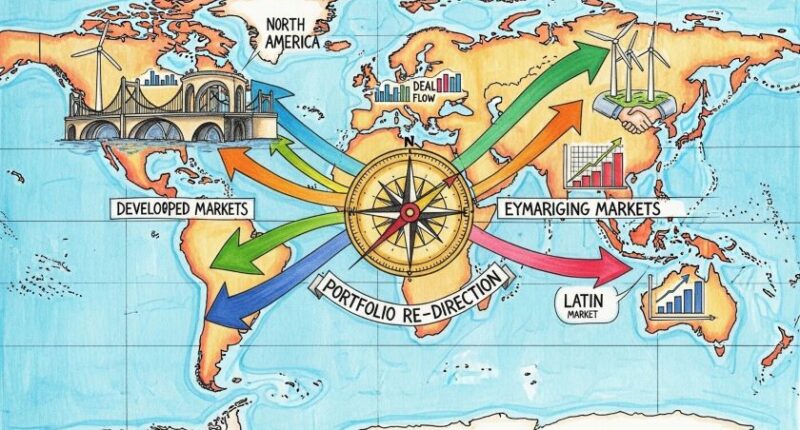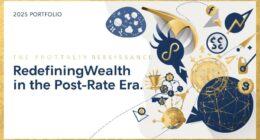Why the old playbook isn’t working
Heading into the late 2025 investment landscape, several familiar pillars are showing cracks. For example, long-term government bond yields are under pressure as fiscal concerns mount — as noted by BlackRock Investment Institute: “Inflation expectations are no longer firmly anchored near 2 %… and bond yields are responding”. BlackRock Meanwhile, global growth is expected to remain modest: the World Bank projects growth in Europe and Central Asia at only 2.4 % in 2025, below the previous decade’s average. World Bank
In short: the one-size-fits-all “buy big stocks, hold long bonds” strategy is less reliable. Investment environments marked by higher yields, greater policy volatility and slower growth call for refreshed thinking. That means smarter diversification, thematic tilts, and being nimble with allocations.
Three themes dominating 2025’s investment blueprint
1. Emerging markets & non-US equities are gaining appeal
While US equities remain dominant, some global strategists now see better value outside North America. The RBC Global Asset Management outlook emphasises that in a base-case scenario of modest growth and contained inflation, “even better performance” is expected from regions outside North America. rbcgam.com Furthermore, emerging market growth is forecast to decelerate but still present long-term opportunity: for example, J.P. Morgan forecasts emerging-market growth at 2.4 % annualised in H2 2025. JPMorgan
Translation for an investor: consider region-tilts toward developed ex-US or select emerging markets, but allocate prudently with attention to valuation, currency and macro risks.
2. Private markets & alternative assets grabbing attention
The public equity markets are crowded and, in many cases, richly valued. By contrast, private markets are showing greater investor intent. According to McKinsey & Company’s 2025 private-markets report, investors “say they will allocate more capital, not less, to private markets over the coming year.” McKinsey & Company
For those with access (high net-worth, institutional, or via funds), this means exploring private equity, real-assets, infrastructure or secondaries. These can offer diversification, illiquidity premium and exposure to sectors less tied to public market sentiment.
3. Infrastructure & real-assets as defensive growth plays
When growth is steady but not stellar, and when inflation or policy risk loom, infrastructure and real assets tend to shine. A recent report notes that infrastructure investing is “emerging as a resilient and attractive option amid ongoing global market volatility” — thanks to stable cash flows, inflation linkage and long-duration earning potential. MoneyWeek
For example, data-centres, utilities, renewable-energy grids and urban infrastructure in growing economies are increasingly on investor radars. That said, they come with challenges: higher entry costs, regulatory scrutiny and often less liquidity.
Key risks to keep on your radar
-
Policy & rate risk: The era of rock-bottom interest rates is over. Bond yields and inflation expectations are rising — meaning both equities and bond portfolios may face headwinds. (See BlackRock’s commentary above.) BlackRock
-
Valuation risk: Some investors warn that the dominance of large tech and mega-cap stocks is nearing a plateau. For example, commentary by Ruchir Sharma points to “ AI mania … getting ahead of itself” and warns of “momentum investing” risk in 2025. Financial Times
-
Liquidity & access risk: Moving into private markets and infrastructure offers upside, but also carries liquidity constraints, upfront capital barriers and potentially longer investment horizons.
-
Emerging-markets & currency risk: The appeal of emerging regions is real, but currency devaluation, foreign-investor flows and local policy shifts can quickly change trajectories.
Practical take-aways for the everyday investor
-
Re-evaluate geographical exposure: Do you have meaningful allocation outside the US? Could you tilt toward developed ex-US or selective emerging markets where valuations are comparatively lower?
-
Don’t forget access: If you’re drawn to private markets or infrastructure, make sure you understand the minimums, liquidity lock-ups and fees. For retail investors, listed infrastructure ETFs and real-asset funds can be a gateway.
-
Re-balance the portfolio: With bonds less reliable as diversifiers and inflation hovering, ensure your portfolio has a mix of assets — equities (with global tilt), real-assets, possibly alternatives — and not overweight on any single theme.
-
Watch the horizon: “The one-speed-fits-all” mindset needs updating. Given slower growth, higher uncertainty and structural shifts (tech, energy transition, infrastructure), alignment of investment horizon and risk tolerance becomes more important than ever.
The bottom line
2025 isn’t a year for “business-as-usual” investing. Instead, it demands a purposeful tilt: consider global diversification (especially non-US), evaluate moving into alternative/illiquid asset classes if your profile allows, and lean on resilient real-asset themes. At the same time, stay mindful of policy shifts, valuation excesses and liquidity constraints. In the evolving terrain of global capital markets, the best returns may come not from repeating past patterns—but from adapting to the new landscape.









